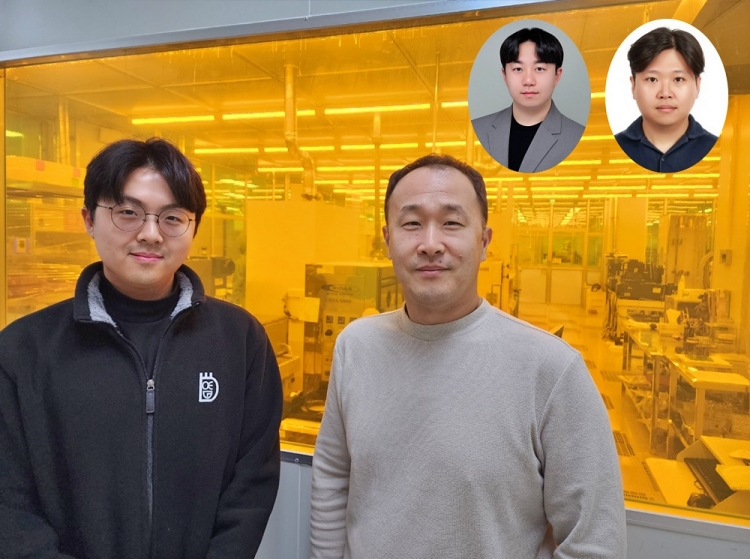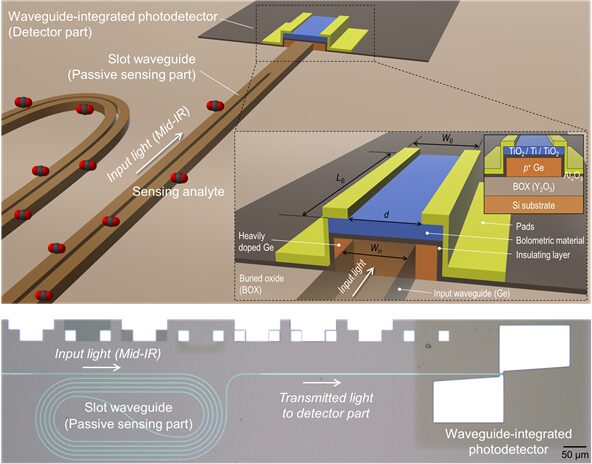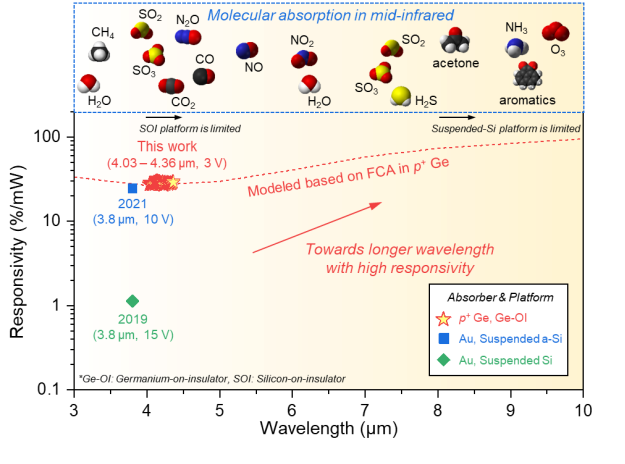
NASA’s James Webb Space Telescope (JWST) utilizes mid-infrared spectroscopy to precisely analyze and identify molecular components such as water vapor and sulfur dioxide in exoplanet’s atmosphere. The key to such mid-infrared analysis—where each molecule exhibits a distinct optical “fingerprint”—lies in highly sensitive photodetector technologies capable of detecting light intensities stably.
EE Prof. SangHyeon Kim’s research team has developed a groundbreaking photodetector capable of detecting a broad range of mid-infrared wavelengths while operating stably at room temperature. This innovation represents a significant advancement toward the commercialization of ultra-compact optical sensing platforms.
The newly developed photodetector is fully compatible with standard CMOS fabrication processes, enabling low-cost and scalable mass production. Its most notable feature is robust, stable operation at room temperature. The research team successfully demonstrated real-time detection of carbon dioxide (CO₂) using this ultra-compact and ultra-thin optical sensor, validating its potential for applications in environmental monitoring and hazardous gas sensing.
Conventional mid-infrared photodetectors typically require cryogenic cooling to mitigate thermal noise at room temperature. These cooling systems increase the overall size, complexity, and cost of the devices, posing challenges for miniaturization and integration into portable or distributed systems. Furthermore, most existing mid-infrared photodetectors are not compatible with CMOS processes, which hinders their large-scale manufacturability and commercial viability.
To address these limitations, Prof. SangHyeon Kim’s research team developed a novel waveguide-integrated photodetector based on a germanium-on-insulator (Ge-OI) photonic platform—leveraging germanium, a group-IV material compatible with CMOS processes. This platform enables broadband mid-infrared detection while ensuring stable operation at room temperature.

A “waveguide” is an optical component designed to efficiently guide light along a specific path with minimal loss. To realize diverse on-chip optical functionalities, the integration of waveguide-based optical components—such as waveguide-integrated photodetectors—is essential.
Unlike conventional photodetectors that rely on wavelength-specific bandgap absorption, the newly developed photodetector exploits the bolometric effect*, enabling broadband photoresponse across the entire mid-infrared spectrum. This approach allows real-time, spectrally non-selective sensing of various molecules. *Bolometric effect: A principle where absorbed light increases the local temperature of a material, which in turn changes in the material’s electrical resistance.
The room-temperature, CMOS-compatible waveguide-integrated mid-infrared photodetector developed by SangHyeon Kim’s research team addresses key limitations of existing technologies—particularly the reliance on cooling systems, limited scalability, and high manufacturing costs.

This technology is expected to find broad applications in areas such as environmental monitoring, industrial process control, medical diagnostics, defense and security, and smart sensing platforms. It provides a crucial technological foundation for the next generation of mid-infrared sensor systems.
Prof. SangHyeon Kim stated, “This research presents a novel approach that overcomes the limitations of existing mid-infrared photodetector technologies and offers significant potential for practical applications across a wide range of fields.” He added, “Thanks to its compatibility with CMOS processes, this sensor can be mass-produced at low cost and will be highly useful in next-generation environmental monitoring systems and smart manufacturing environments.”

This research was published on March 19, 2025, in the prestigious international journal Light: Science & Applications (JCR top 2.9%, IF = 20.6). The first author is Dr. Joonsup Shim, currently a postdoctoral researcher at Harvard University. (Paper title: Room-temperature waveguide-integrated photodetector using bolometric effect for mid-infrared spectroscopy applications, DOI: https://doi.org/10.1038/s41377-025-01803-3)
This work was supported by the National Research Foundation (NRF) of Korea.